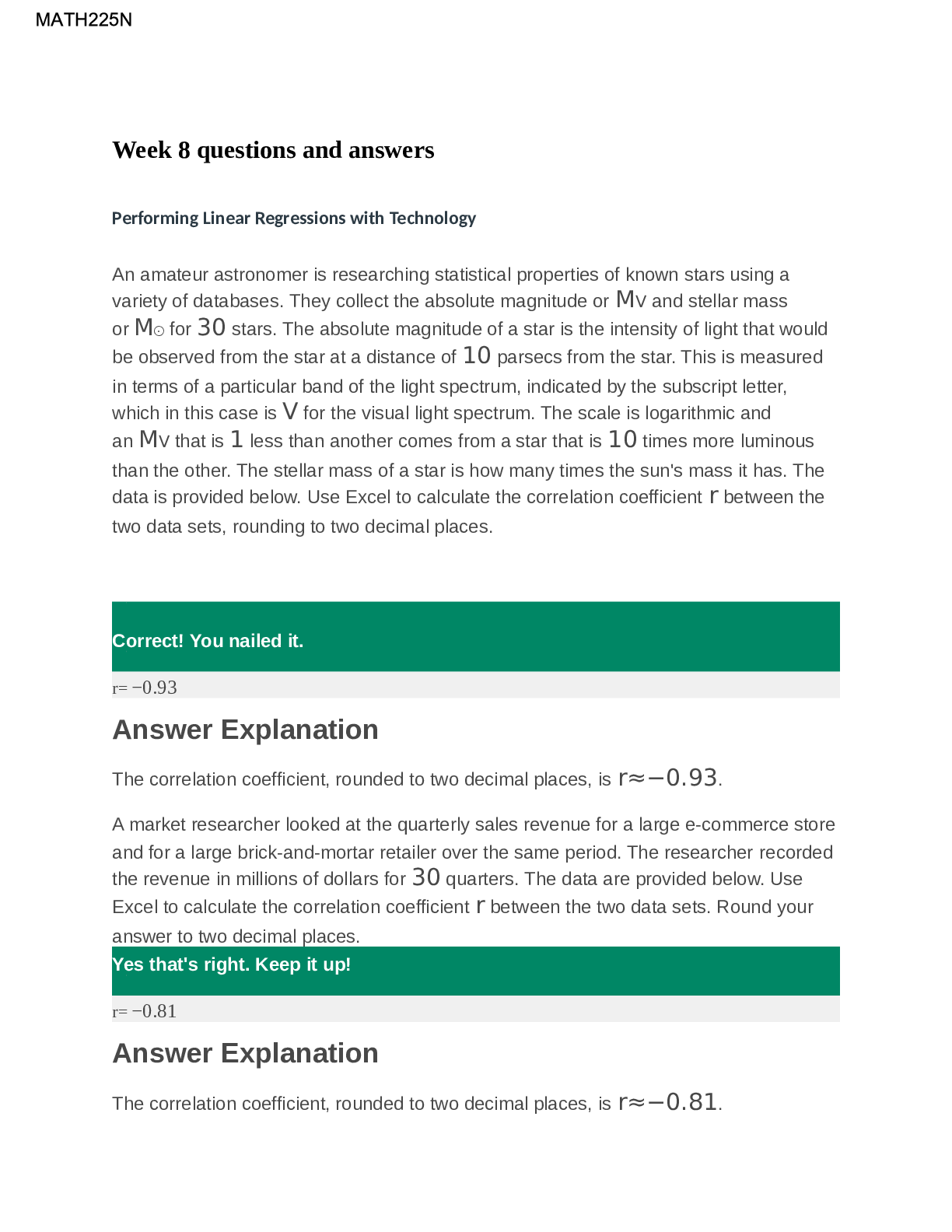Human Resource Management > EXAM > E 06 lesson 6 and 7 updated Questions and Answers Study Guide Mostly Tested Questions (All)
E 06 lesson 6 and 7 updated Questions and Answers Study Guide Mostly Tested Questions
Document Content and Description Below
E 06 lesson 6 and 7 updated Questions and Answers Study Guide Your quiz has been submitted successfully. Question 1 2.5 / 2.5 points A third-grade student with special needs seems to be disengaged... from the project being completed in a small group. The teacher takes her aside and asks why she isn't completing the work. The student shares that she believes she isn't as smart as the other students and therefore has nothing to contribute to the group. How should the teacher respond? Question options: a) "I understand how you feel, but you have to complete your work anyway. If I let you drop out of the group, other children will want to also." b) "Yes, you seem frustrated by this group work. Why don't you go and work at the computer by yourself?" c) "People are smart in different ways. I know that your classmates admire your ability to draw. Maybe that is your way to help the group." d) "I see your frustration; I'm sorry that you are having a bad day." Question 2 2.5 / 2.5 points ________involves the process of discovering a child's knowledge, abilities, and interests. Question options: a) Performance assessment b) A teacher made test c) Curriculum d) Standardized testing Question 3 2.5 / 2.5 points Before leaving language arts class, the teacher asks students to discuss their role in the group work completed that day. Why should a teacher spend time on this? Question options: a) It allows students an opportunity to use their verbal skills. b) Students can share what they learned with the entire class. c) Students not only self-evaluate but also reflect on others' contributions to the group. d) A discussion is a good way to calm students before leaving the room. Question 4 2.5 / 2.5 points Which of the following is a TRUE statement about brain research? Question options: a) Early social and emotional experiences are the seeds of human intelligence. b) Different regions of the brain are actively developing and maturing according to timetables. c) Children who don't play much develop smaller brains. d) All of the above Question 5 0 / 2.5 points Examples of leadership activities that support conceptual leadership include all of the following EXCEPT: Question options: a) writing a position paper on an area of children's creative expression, having it reviewed by experts, and posting it on the web. b) developing an informative flyer that can be shared with the general public about an important area of children's creative expression. c) joining a task force that focuses on children's creative expression. d) making a professional presentation on children's creative expression. Question 6 2.5 / 2.5 points Robinson highlights that one of the challenges with creativity is: Question options: a) allowing kids to be creative. b) proving creativity is worthwhile. c) assessing the value of creativity. d) guiding children's creative projects. Question 7 2.5 / 2.5 points Brain research suggests all of the following significantly contribute to a child's well-being EXCEPT: Question options: a) good prenatal care. b) detachment between young children and adults. c) positive stimulation from the time of birth. d) age-appropriate stimulation from the time of birth. Question 8 2.5 / 2.5 points Parents and families need to be involved in assessing children's growth. Teachers should foster this involvement by all of the following EXCEPT: Question options: a) giving parents/families opportunities to provide written feedback on their children's work. b) conferencing with parents/families regarding their children's progress. c) permitting parents/families to visit the classroom only on special days, such as field trips. d) having families review taped or individual performances of their children. Question 9 2.5 / 2.5 points All of the following practices support gifted and talented students EXCEPT: Question options: a) pulling children to participate in gifted programs. b) using flexible grouping strategies that respect competency in each subject. c) not forcing children to study material they have mastered. d) recognizing the unique needs of gifted students. Question 10 2.5 / 2.5 points Which of the following are reasons for assessing divergent/lateral thinking? Question options: a) To determine the impact of an educational program on young children's growth in creative expression and play b) To identify talents c) To provide enrichment and develop potential through special programs d) All of the above Question 11 2.5 / 2.5 points Assessment of creative thinking and arts-based learning should help teachers to: Question options: a) identify and respond appropriately to the needs of individual children. b) make instructional decisions that benefit the child. c) evaluate program effectiveness. d) All of the above Question 12 2.5 / 2.5 points Studies show that most families make ________ a part of their child's daily experiences. Question options: a) dramatic play b) dance c) painting d) music Question 13 0 / 2.5 points Throughout the school year, a second-grade teacher uses learning centers during science. What is the best way to evaluate student learning during these activities? Question options: a) Observe students during center time to determine if they understand the science concepts. b) Wait until students complete activities and give them a written test afterward. c) Incorporate ways for students to record their observations; for example, a sink/float chart or a record of which items attracted/repelled a magnet. d) Have students write a sentence about what they learned at each center. Question 14 2.5 / 2.5 points One purpose for using anecdotal records includes: Question options: a) highlighting student attitudes, preferences, judgments, and participation. b) comparing one child's progress with that of the typically developing child. c) demonstrating emerging understanding of creativity and the arts. d) providing evidence of the learning that was achieved through the course of a major project. Question 15 2.5 / 2.5 points One of the most valuable assessment tools available to teachers is/are: Question options: a) a standardized test. b) a teacher made test. c) formal testing methods. d) observation. Question 16 2.5 / 2.5 points A good observation should include: Question options: a) high inference appraisals of children's behavior. b) terminology that labels the child. c) a detailed description of the context in which the behavior occurred. d) very general information. Question 17 2.5 / 2.5 points Creativity is an important resource with ________ significance. Question options: a) social b) economic c) cultural d) All of the above Question 18 2.5 / 2.5 points Which of the following supports children's creative thinking? Question options: a) Let's look at these two pictures. b) What did you think of the story? c) What do you predict will happen when…? d) How do you know that is true? Question 19 2.5 / 2.5 points Parents shape their children's talent by all of the following ways EXCEPT: Question options: a) offering moral support. b) encouraging self-evaluation. c) offering advice or giving explicit instruction. d) setting low standards. Question 20 0 / 2.5 points Appropriate observations of children: Question options: a) have high-inference, value-laden terminology. b) record inferred behaviors. c) lack details of the context in which the behavior occurred. d) become the basis for planning a high quality program. Question 21 2.5 / 2.5 points Providing large spaces in which children can easily move and work is an appropriate modification for a student with a(n) ___________ disability. Question options: a) physical b) visual c) auditory d) emotional Question 22 2.5 / 2.5 points When planning a learning center, which of the following must be considered? Question options: a) Guidelines for meeting standardized testing content b) Teacher interests c) Special needs of children d) The cost of the materials Question 23 2.5 / 2.5 points Within enriched classroom environments, children engage in ________ activities. Question options: a) self-selected b) self-directed c) teacher-selected d) All of the above Question 24 2.5 / 2.5 points An appropriately designed outdoor play space allows children to: Question options: a) run freely without limits. b) play competitive games. c) retain ownership of their play. d) always know what they are going to play. Question 25 2.5 / 2.5 points The teacher values the interactions of many environments, such as family, school, neighborhood, and peers that are all connected. Who would support this classroom practice? Question options: a) Bronfenbrenner b) Montessori c) Malaguzzi and Reggio Emilia Schools d) Vygotsky Question 26 0 / 2.5 points According to brain research, all of the following emotions are commonly seen in the classroom EXCEPT: Question options: a) joy/pleasure b) fear/threat c) humor/silliness d) sadness/disappointment Question 27 2.5 / 2.5 points Providing easy access to materials is facilitated by: Question options: a) placing materials out of children's reach. b) having clearly marked spaces on shelves. c) assigning children certain times to select materials. d) limiting the amount of materials that can be taken out at one time. Question 28 2.5 / 2.5 points For materials to enhance the creative environment, they must: Question options: a) suggest only one right answer. b) be inaccessible. c) be difficult to use. d) capture children's attention. Question 29 2.5 / 2.5 points A representative of a parent group affiliated with the school approaches a teacher about making improvements to the playground. She asks for suggestions from the teacher about establishing a creative, safe play environment for students. What are good suggestions the teacher can offer? Question options: a) Remove all the existing equipment and replace the surface with natural materials that provide some cushioning so that wide, open spaces are maximized. b) Gather information on children's preferences and developmentally appropriate play spaces, consider how many children can be accommodated by each piece of equipment, designate areas in which children can engage in different types of outdoor activities, and consider how to make the playground accessible to children with special needs. c) Hire a professional designer to make the playground visually appealing to adults and install as much stationary new equipment as the group can afford. d) Focus on inexpensive equipment (e.g., balls, hula hoops, jump ropes, hopscotch) to get the most for the money spent. Question 30 0 / 2.5 points Routines and transitions should NOT be: Question options: a) carefully planned. b) a time for decision-making. c) a learned, consistent activity. d) unsupervised. Question 31 2.5 / 2.5 points Classrooms that hinder children's creativity are product-oriented and have: Question options: a) teachers who criticize creative thinking. b) children who are absorbed in learning. c) materials that capture and sustain children's interests. d) design features that evoke a warm, homelike quality. Question 32 2.5 / 2.5 points Using carpet and corkboard walls to reduce classroom noise, is an appropriate modification for a student with a(n) ____________ disability. Question options: a) physical b) visual c) auditory d) emotional Question 33 2.5 / 2.5 points Professional organizations for teachers have a set of standards for establishing high-quality classroom environments. These standards indicate that the classroom environment should support: Question options: a) children's honest expression and thinking, displays of children's work, autonomy for infants and toddlers, and children's feeling of ownership. b) children's feeling of ownership, autonomy for infants and toddlers, displays of children's work, and varied experiences through learning centers. c) assessment of children's work, displays of children's work, children's feeling of ownership, and children's honest expression and thinking. d) displays of children's work, teacher-directed activity centers, children's feeling of ownership, and assessment of children's work. Question 34 2.5 / 2.5 points In order to plan and arrange classrooms for creativity and arts-based learning, teachers need to: Question options: a) know the children, and how best to guide their learning. b) provide teacher-directed activities for children's use. c) adhere to a published curriculum guide. d) release all control over the classroom. Question 35 2.5 / 2.5 points Which theorist believes in displaying children’s work to show that children and their work are valued and respected? Question options: a) Bronfenbrenner b) Montessori c) Malaguzzi and Reggio Emilia Schools d) Vygotsky Question 36 2.5 / 2.5 points Using lighting that does not cast shadows or a glare on schoolwork and activities, is an appropriate modification for a student with a(n) ____________ disability. Question options: a) physical b) visual c) auditory d) emotional Question 37 2.5 / 2.5 points Components of a well-planned daily routine include: Question options: a) having children sit in their seats as soon as they arrive. b) reviewing the available choices for the day. c) establishing tight time frames for each planned activity/lesson. d) allowing children to move at will from center to center without guidance. Question 38 2.5 / 2.5 points Which of the following theorists and early childhood educators have promoted this concept to the greatest extent when a teacher describe the classroom environment as another “teacher?” Question options: a) Vygotsky and Bandura b) Montessori and Malaguzzi c) Bronfenbrenner and Maslow d) Adler and Skinner Question 39 2.5 / 2.5 points A teacher scaffolds children’s thinking and relationships with one another. Who would support this classroom practice? Question options: a) Bronfenbrenner b) Montessori c) Malaguzzi and Reggio Emilia Schools d) Vygotsky Question 40 2.5 / 2.5 points When supervising outdoor play, teachers should: Question options: a) circulate around the area. b) work alone and give others a short break. c) take a ten-minute break d) focus on students who often cause trouble. ________________________________________ Attempt Score: 88 / 100 - 87.5 % Overall Grade (highest attempt): 88 / 100 - 87.5 % Done [Show More]
Last updated: 2 years ago
Preview 1 out of 22 pages

Buy this document to get the full access instantly
Instant Download Access after purchase
Buy NowInstant download
We Accept:

Reviews( 0 )
$13.00
Can't find what you want? Try our AI powered Search
Document information
Connected school, study & course
About the document
Uploaded On
Dec 18, 2020
Number of pages
22
Written in
Additional information
This document has been written for:
Uploaded
Dec 18, 2020
Downloads
0
Views
164

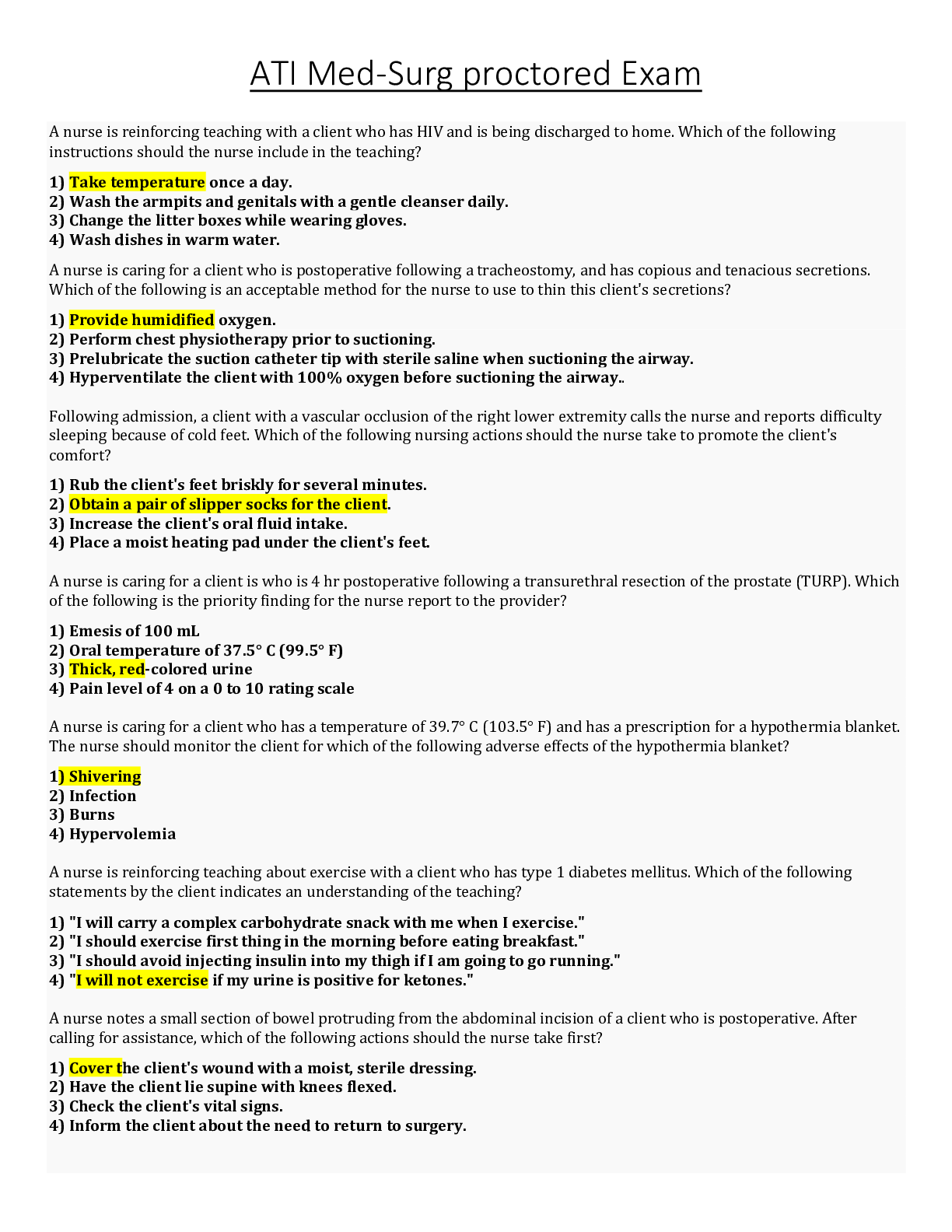

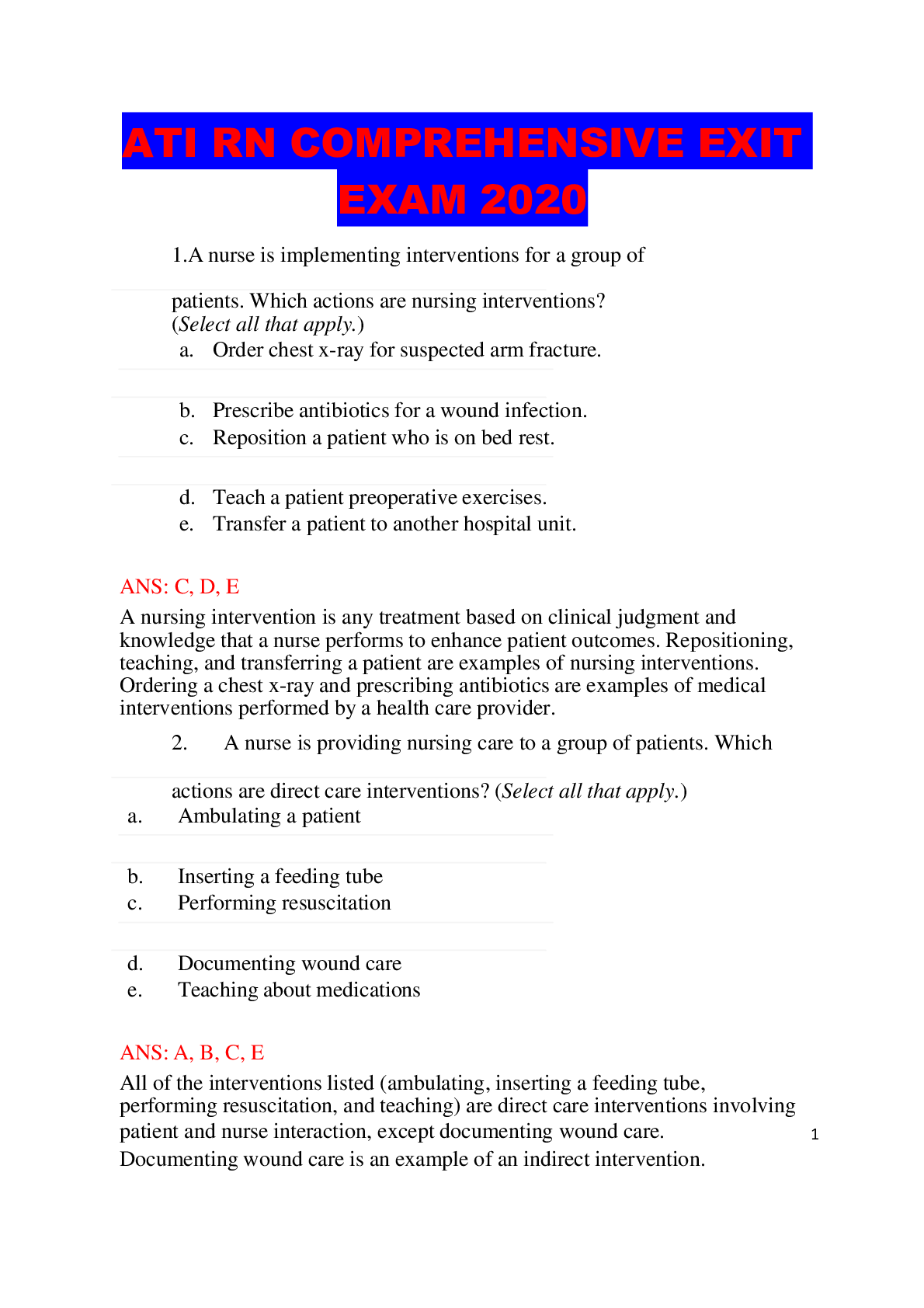
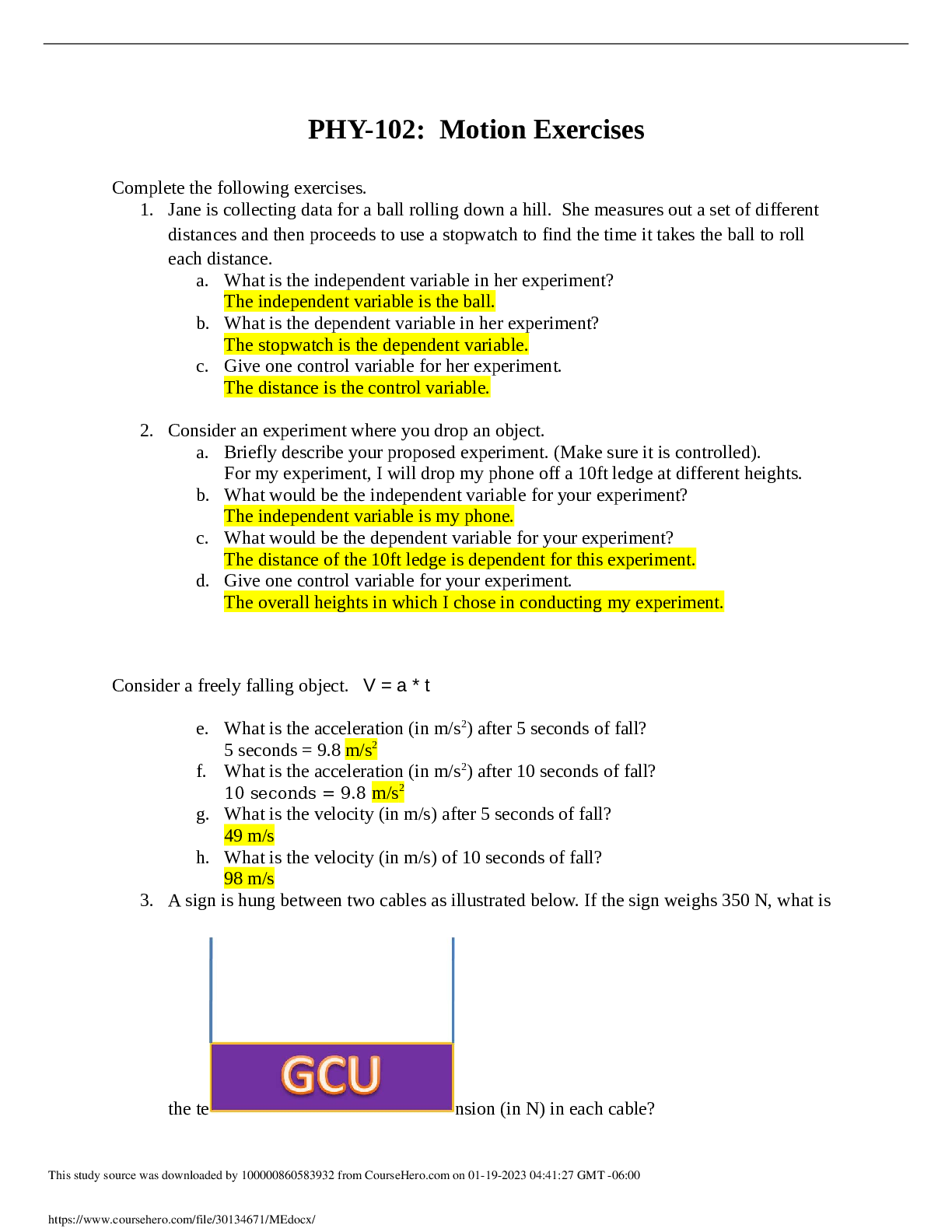
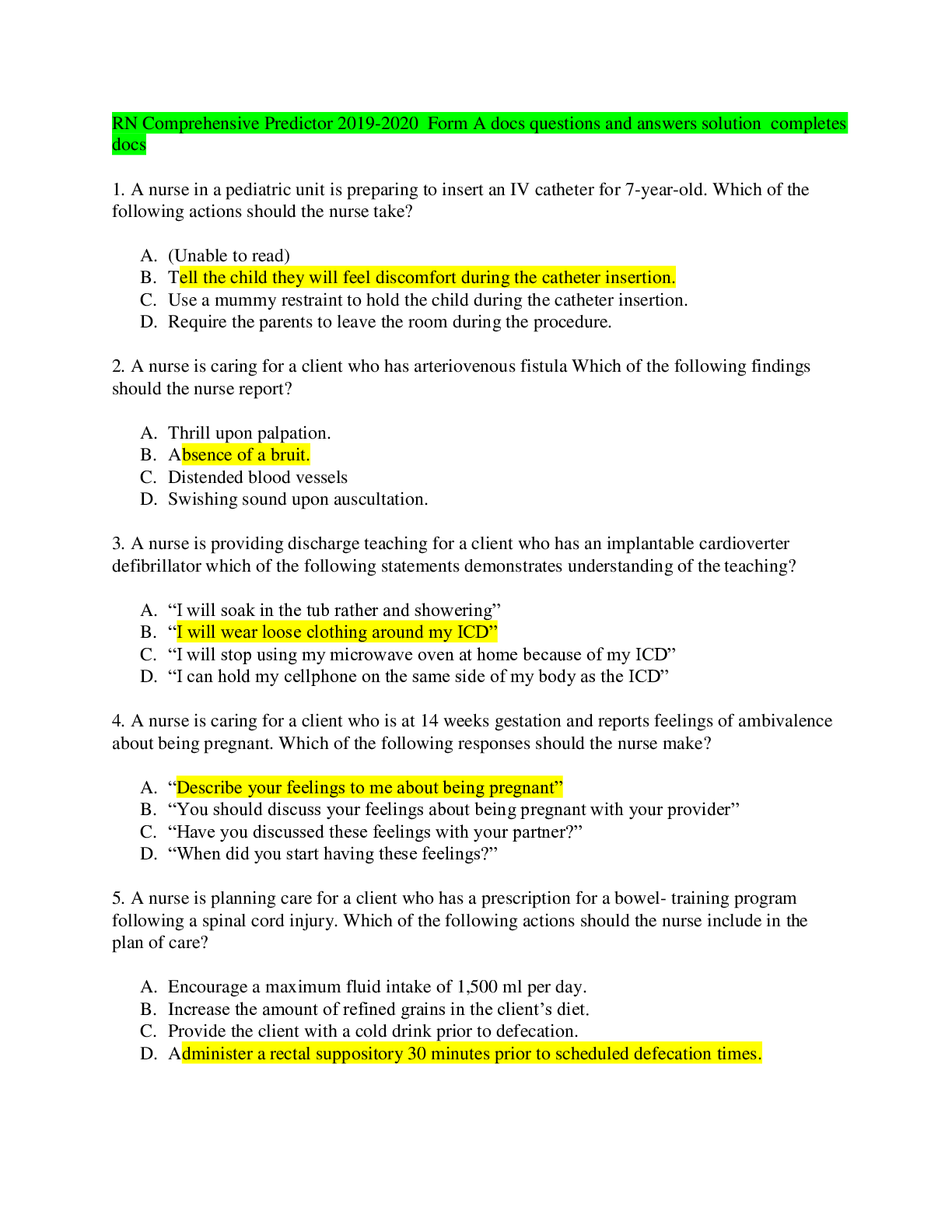


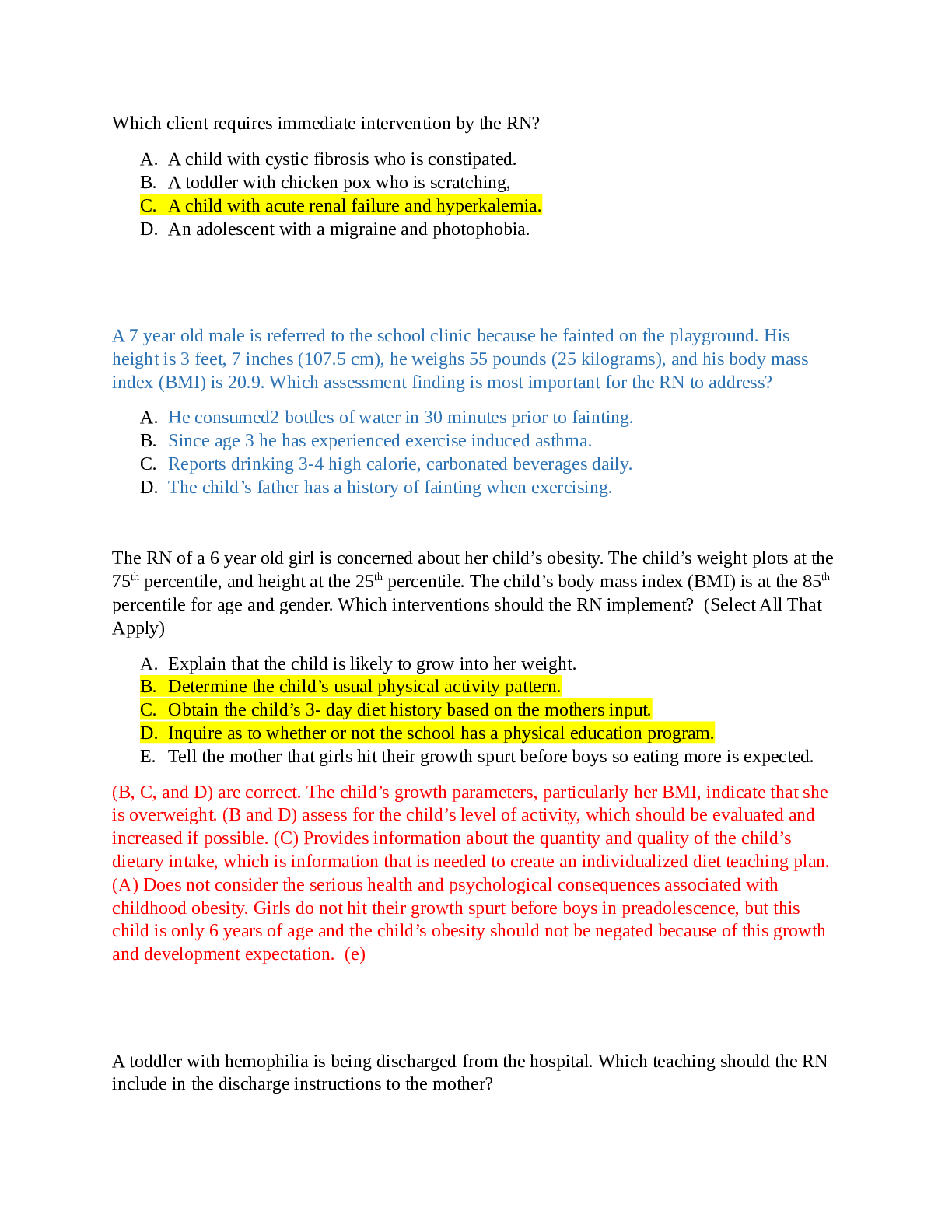



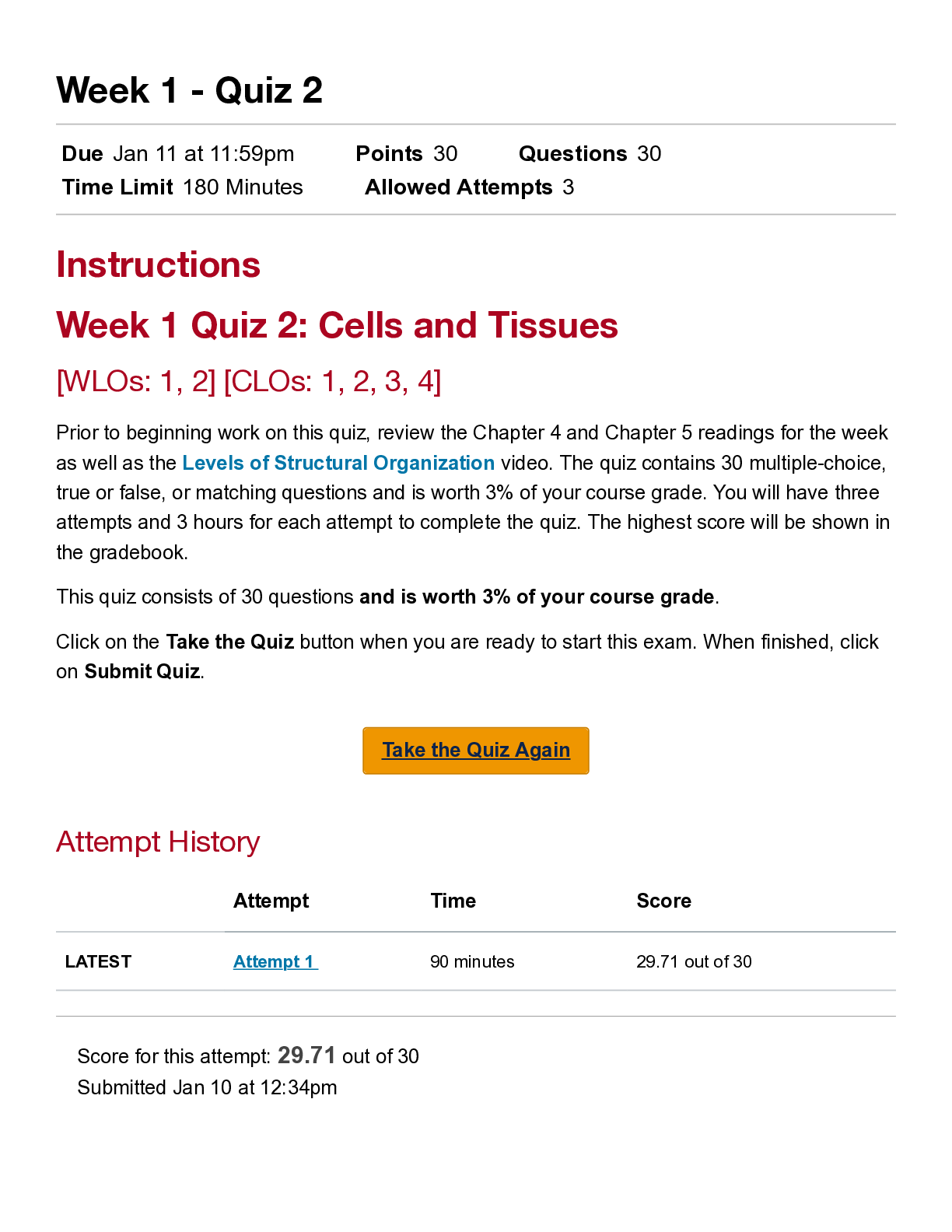

.png)

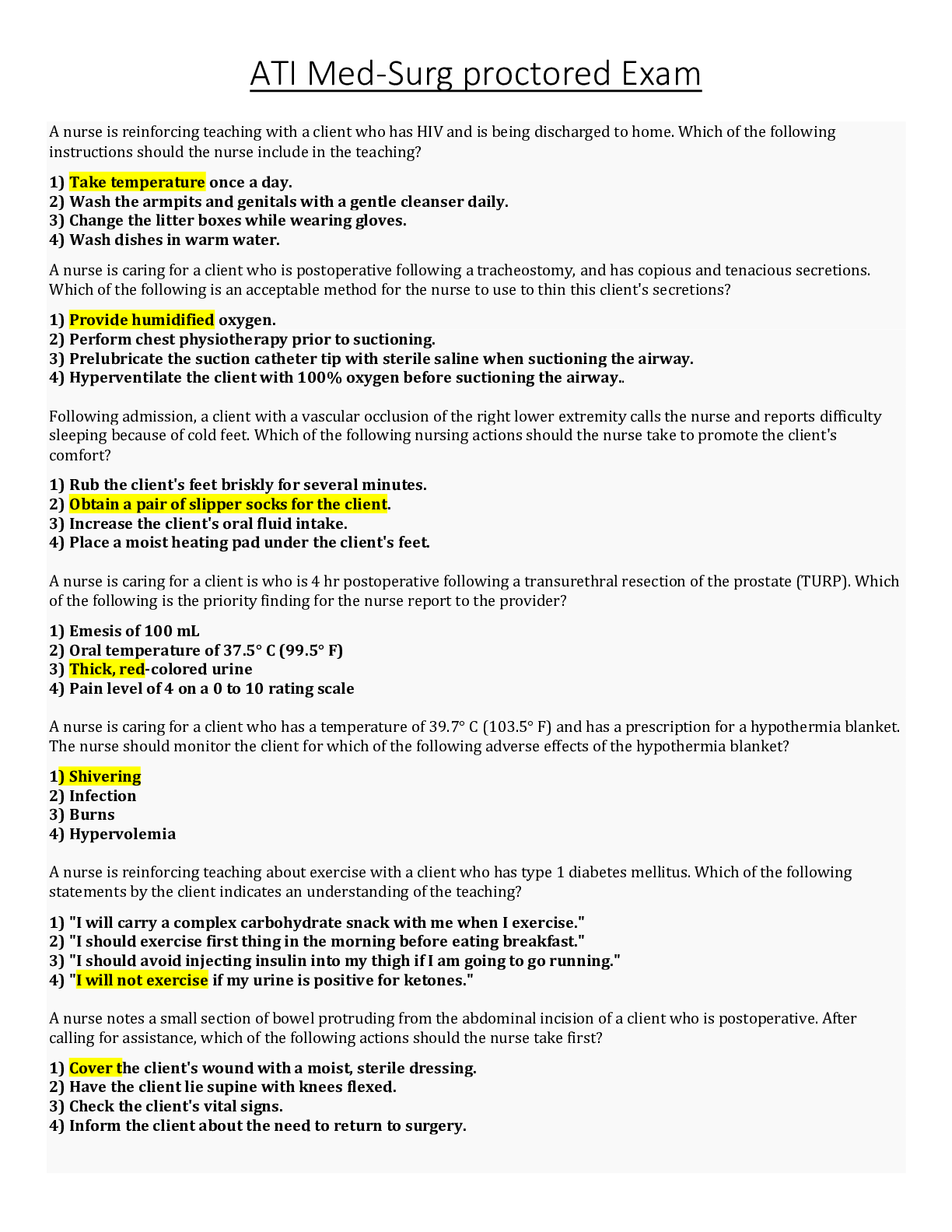
.png)


